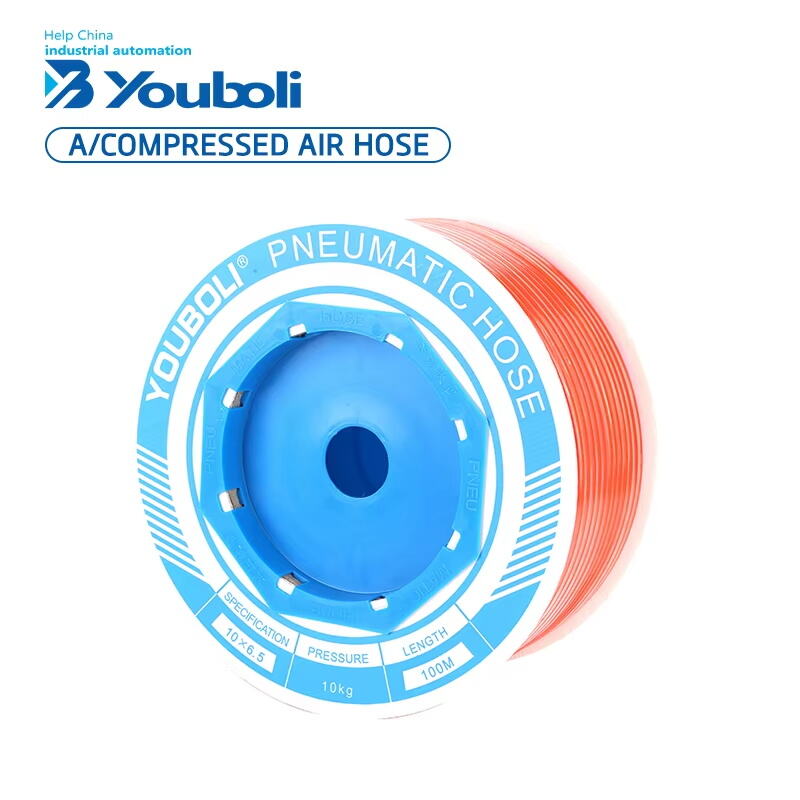Introduction
Have you ever faced an air leak in your pneumatic system that brought production to a halt? Or struggled with a complicated installation process that took far longer than expected? If so, you're not alone. The heart of any efficient pneumatic system lies in its connections—the humble air fittings. While often overlooked, choosing the right type of air fitting is critical for ensuring optimal performance, safety, and cost-efficiency. This comprehensive guide is designed to demystify the world of pneumatic air fittings. We will explore the various types available, with a special focus on the innovative Pneumatic Push-In Fittings, and provide you with the knowledge to select the perfect fitting for your specific application. Whether you're a seasoned engineer or new to the field, this article will equip you with actionable insights to enhance your system's reliability and performance.
Why the Right Air Fitting Matters: More Than Just a Connection
Before we dive into the types, it's crucial to understand why this component deserves your attention.
System Efficiency and Performance: A leaky or restrictive fitting can cause a significant pressure drop, reducing the power and speed of your pneumatic cylinders and tools. This leads to slower cycle times and diminished overall system performance.
Operational Costs: Compressed air is expensive to generate. The U.S. Department of Energy estimates that leaks can account for 20-30% of a compressor's output. Properly selected and installed fittings are your first line of defense against wasting energy and money.
Safety and Reliability: Pneumatic systems operate under high pressure. A failed connection can lead to dangerous hose whip, sudden loss of control in machinery, or even injury. Secure fittings are non-negotiable for a safe work environment.
Maintenance and Downtime: Fittings that are difficult to install or require special tools can turn a simple maintenance task into a lengthy ordeal, increasing machine downtime and labor costs.
Simply put, the right fitting ensures your system operates at peak efficiency, safely, and with minimal waste.
What Are Pneumatic Air Fittings? Defining the Core Concept
At its most basic, a pneumatic air fitting is a connector used to join sections of pipe, tube, or hose in a compressed air system. Their primary functions are to:
Create a secure, leak-free seal.
Allow for easy connection and disconnection for maintenance or reconfiguration.
Change the direction of flow (e.g., elbows, tees).
Adapt between different thread standards, port sizes, or hose types.
Fittings are characterized by several key attributes:
Thread Type: NPT (National Pipe Taper), BSPP (British Standard Pipe Parallel), BSPT (British Standard Pipe Taper), and metric threads are the most common. Using the wrong thread type will not seal properly.
Size: This refers to the port size (e.g., 1/8", 1/4") and the tubing outer diameter (OD) it is designed to accept (e.g., 4mm, 6mm, 8mm, 12mm).
Material: Most are made from brass (for corrosion resistance and good machinability), stainless steel (for high corrosion or temperature environments), or engineered plastics (for cost-sensitive, low-pressure applications).
Configuration: Straight connectors, elbows, tees, crosses, and reducers are all standard shapes for different routing needs.
A Deep Dive into the Different Types of Pneumatic Fittings
Here, we break down the most prevalent types of air fittings, their mechanisms, and their ideal use cases.
1. Push-to-Connect Fittings (Pneumatic Push-In Fittings)
This is the modern, user-friendly solution that has revolutionized pneumatic assembly.
What Are They?
Push-in fittings, often called push-to-connect fittings, allow for instantaneous tube connection without tools. You simply push a prepared tube into the fitting, and an internal collet and O-ring grip and seal it. To disconnect, you press down on the release collar and pull the tube out.
How Do They Work?
The magic lies in their internal design:
O-Ring: Provides the primary air-tight seal against the tube.
Collet (or Grip Ring): A stainless steel ring with teeth that bites into the tube, preventing it from being pulled out under pressure.
Release Collar: When depressed, it disengages the collet, allowing the tube to be removed.
Advantages and Disadvantages of Push-In Fittings
-
Advantages:
Lightning-Fast Installation: Drastically reduces assembly and maintenance time. Studies have shown a time savings of up to 50% compared to threaded alternatives.
Tool-Free: No wrenches, sealants, or specialized skills required.
Reusable: Can be used repeatedly on the same tube or a new one (after trimming the old tube end).
Vibration Resistant: Excellent performance in applications with high vibration, where threaded fittings might loosen.
Leak-Free Seal: The O-ring provides a highly reliable seal when installed correctly.
-
Disadvantages:
Higher Initial Cost: Per fitting, they are typically more expensive than basic compression or barbed fittings.
Tubing Preparation: The tube end must be cut cleanly (90 degrees) and deburred. A ragged or angled cut will damage the O-ring and cause leaks.
Tube Compatibility: Designed for specific, standardized tubing OD (e.g., nylon or polyurethane). They are not suitable for soft, non-standard, or irregular tubing.
Temperature Limitations: The internal O-ring may have lower temperature ratings than a all-metal threaded fitting.
2. Compression Fittings
A longstanding, reliable technology that offers a robust metal-to-metal seal.
What Are They?
Compression fittings use a mechanical compression force to create a seal. They consist of three parts: the fitting body, a compression nut, and a ferrule (or olive ring). As the nut is tightened, it compresses the ferrule onto the tubing, forming a tight seal.
Advantages and Disadvantages
-
Advantages:
Robust and Reliable: Excellent for high-pressure applications and metal tubing.
No Threads on Tubing: The seal is made on the tube itself, not on a thread.
Good Resistance to Pull-Out: Once compressed, the ferrule provides a strong grip.
-
Disadvantages:
Time-Consuming: Requires wrenches and careful tightening. Over-tightening can damage the ferrule or tube, under-tightening will leak.
Generally Not Reusable: The ferrule is often deformed during installation and cannot be reused, making reconfiguration messy.
Can Be Bulkier: The need for a nut and ferrule can make them larger than equivalent push-in fittings.
3. Barbed Fittings (Hose Barbs)
The simplest and most cost-effective solution for low-pressure applications.
What Are They?
Barbed fittings have a ridged, tapered end (the "barb") over which soft tubing is pushed. The tubing is then almost always secured with a clamp (e.g., gear clamp or spring clamp) to prevent it from slipping off under pressure.
Advantages and Disadvantages
-
Advantages:
Extremely Low Cost: The most inexpensive type of fitting.
Simple Design: Very easy to understand and source.
Flexible Tubing: Works well with a variety of soft tubing materials.
-
Disadvantages:
Poor Pull-Out Resistance: Relies entirely on the clamp and friction.
Higher Risk of Leaks: The seal is not as positive as with other types.
Not for High Pressure: Suitable only for low to medium-pressure systems.
Difficult Disassembly: Once clamped and aged, the tubing can be very difficult to remove.
4. Quick-Disconnect (QD) Couplings
Designed for applications where tools or equipment need to be frequently connected and disconnected.
What Are They?
These fittings have two parts: a plug (male) and a socket (female). The plug is inserted into the socket, and a locking mechanism (often a sleeve that is pulled back) secures them together, creating a seal. When the sleeve is retracted, the plug is released.
Advantages and Disadvantages
-
Advantages:
Ultra-Fast Connection/Disconnection: Ideal for portable tools, air blow guns, and other frequently changed equipment.
Automatic Shut-Off: Many high-quality QD couplings have a valving mechanism that shuts off airflow when disconnected, saving energy and enhancing safety.
-
Disadvantages:
Pressure Drop: Can cause a significant restriction and pressure drop in the airflow path.
Not for Permanent Lines: They are purpose-built for points of disconnection, not for runs of tubing.
How to Choose the Right Fitting: A Step-by-Step Guide
Selecting the best fitting for your job doesn't have to be guesswork. Follow this checklist:
-
Identify Operating Pressure (PSI/Bar): What is the maximum pressure in your system?
Push-In & Compression: Excellent for full-range pneumatic pressures (up to 150-250 PSI standard).
Barbed: Best for lower pressures (<100 PSI).
-
Determine Tubing Type and Size (OD): This is the most critical factor.
Measure the tubing's Outer Diameter (OD) precisely. Push-in fittings are highly specific to OD (e.g., a fitting for 8mm tube will not work with 1/4" tube, even though they are close).
Confirm material compatibility (nylon, polyurethane, etc.).
-
Assess the Application Environment:
Vibration? Push-in fittings are the superior choice.
High Temperature? Metal compression fittings may be better than standard push-in fittings with Buna-N O-rings (though Viton O-rings are available for higher heat).
Chemicals or Oils Present? Select brass or stainless steel with chemical-resistant O-ring material.
-
Consider Frequency of Disassembly:
Frequent changes: Push-In or Quick-Disconnect.
Semi-permanent installation: Compression.
Very permanent, low-cost: Barbed.
Verify Thread Specifications: Ensure the port thread on your equipment (cylinder, valve, compressor) matches the thread on your chosen fitting (NPT, BSPP, etc.). Using an adapter is always an option but adds cost and potential leak points.
Pro Tips for Installation and Maintenance
For Push-In Fittings: Always, without exception, cut the tube square and deburr it. A dedicated tube cutter is a worthwhile investment. After cutting, inspect the end for any imperfections and gently chamfer the outer edge. Insert the tube until you feel it bottom out and give a slight tug to ensure it's locked.
For Compression Fittings: Use two wrenches—one to hold the fitting body and one to tighten the nut. This prevents twisting and damaging the entire assembly. Follow the manufacturer's recommendation for torque or turn-off (typically 1.25 to 1.5 turns after hand-tight).
General Best Practice: Conduct a regular leak-down test on your system. Pressurize the system, shut off the compressor, and monitor the pressure drop over time. A significant drop indicates leaks that need to be addressed, often at fitting connections.
Conclusion: Making the Informed Choice
The world of pneumatic air fittings is diverse, but understanding the core types—Push-In, Compression, Barbed, and Quick-Disconnect—empowers you to build and maintain better, more efficient systems. While each type has its place, the innovation and ease-of-use of Pneumatic Push-In Fittings have made them the go-to choice for modern industrial applications, offering an unparalleled blend of speed, reliability, and performance.
By carefully considering your system's pressure, tubing, environment, and needs, you can select the perfect fitting to eliminate leaks, reduce downtime, and save on energy costs. Remember, the smallest component can often have the biggest impact on your operation's success.

